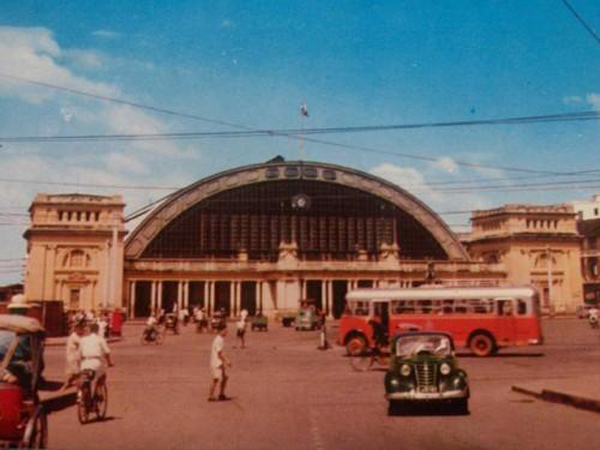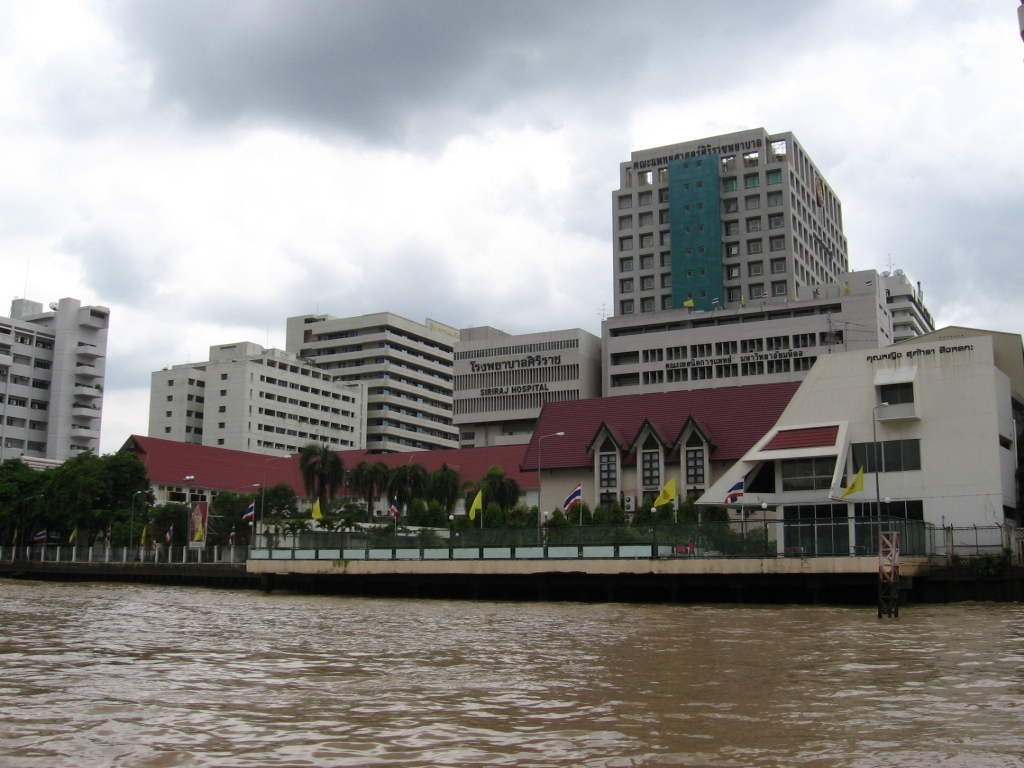|
Thon Buri Railway Station
Thon Buri railway station () formerly known as Bangkok Noi railway station (สถานีรถไฟบางกอกน้อย), is a class 1 railway station and the current terminus of the Thon Buri Branch Line in Bangkok. Near the station is a railway depot that keeps five functional steam locomotives operable for four special occasions. Thon Buri station is the only station in Bangkok that has railway semaphore signals (although unused) still present on the station grounds. Despite its name, the station does not relate to Thon Buri district, which instead is located in Bangkok Noi district. History Originally, the station's location was at Bangkok Noi railway station. It opened in 1903 as a terminus for all Southern Line services. The station was the site of the 0 km mark for the Southern Line. During World War II it was bombed by the Allies as it was a Japanese logistical centre. After the war, the station was rebuilt and was named ''Thon Buri'', opening in ... [...More Info...] [...Related Items...] OR: [Wikipedia] [Google] [Baidu] |
Southern Line (Thailand)
Southern Line () is a metre-gauge railway line in Thailand, operated by State Railway of Thailand (SRT), which runs through most of the provinces in the Central, Western, and Southern regions of Thailand. At 1,144.29 kilometres in length, it is Thailand's longest railway line. History In 1894, the Danish engineer Aage Westenholz (1859–1935), uncle of the writer Karen Blixen, was given the concession to build a route from Bangkok to Phetchaburi. The project failed due to the difficulty of raising sufficient capital. As a result, the Thai state decided in 1898 to build the main rail lines and bought back the concession. Other concession requests made by railroad entrepreneurs in the Thai part of the Malay Peninsula were all rejected. After the Thai state had repurchased the West timber concession, the Royal Railway Department (RRD) in the Ministry of Public Works planned a route, under Karl Bethge from the Krupp Company to Phetchaburi. The construction work began in April 19 ... [...More Info...] [...Related Items...] OR: [Wikipedia] [Google] [Baidu] |
Railway Stations In Thailand Opened In 1999
Rail transport (also known as train transport) is a means of transport using wheeled vehicles running in tracks, which usually consist of two parallel steel rails. Rail transport is one of the two primary means of land transport, next to road transport. It is used for about 8% of passenger and freight transport globally, thanks to its energy efficiency and potentially high speed.Rolling stock on rails generally encounters lower frictional resistance than rubber-tyred road vehicles, allowing rail cars to be coupled into longer trains. Power is usually provided by diesel or electric locomotives. While railway transport is capital-intensive and less flexible than road transport, it can carry heavy loads of passengers and cargo with greater energy efficiency and safety. Precursors of railways driven by human or animal power have existed since antiquity, but modern rail transport began with the invention of the steam locomotive in the United Kingdom at the beginning of the 19th c ... [...More Info...] [...Related Items...] OR: [Wikipedia] [Google] [Baidu] |
Hua Lamphong Railway Station
Bangkok (Hua Lamphong) railway station (, ) is a railway station in Pathum Wan, the former central passenger terminal in Bangkok and the former railway hub of Thailand. It is in the center of the city in the Pathum Wan district, and is operated by the State Railway of Thailand (SRT). Long distance trains moved to the new central station at Krung Thep Aphiwat Central Terminal in 2023. Naming The station was officially referred to by the State Railway of Thailand as Bangkok railway station or ''Sathani Rotfai Krung Thep'' (สถานีรถไฟกรุงเทพ) in Thai. Hua Lamphong () was originally the informal name of the station, used by locals, tourist guides and the public press. In all documents published by the State Railway of Thailand (such as train tickets, timetables, and tour pamphlets) the station is uniformly transcribed as Krungthep (กรุงเทพ) in Thai. As of 19 January 2023, following the opening of Krung Thep Aphiwat Central Terminal, the ... [...More Info...] [...Related Items...] OR: [Wikipedia] [Google] [Baidu] |
Krung Thep Aphiwat Central Terminal
Krung Thep Aphiwat Central Terminal (, , ; ), also known by its former name Bang Sue Grand Station (, , ; ), is the central station of Thailand. Located along the border of Chatuchak district and Bang Sue district, it replaced the existing Hua Lamphong railway station as the country's central station, with long-distance rail services operating from here from 19 January 2023. The station was opened on 2 August 2021 as part of the operation of the SRT Red Lines, and from May 2021 to September 2022 served as a COVID-19 vaccination center. It is linked to the Bang Sue MRT station via an underground walkway. The name ''Krung Thep Aphiwat Central Terminal'' was chosen by King Vajiralongkorn. It is the largest railway station in Southeast Asia, with 26 platforms—some long. The station will offer of usable floor space. The 15 billion baht station is built on of SRT-owned land and will have maintenance depots for both diesel and electric trains. Currently, long-distance intercit ... [...More Info...] [...Related Items...] OR: [Wikipedia] [Google] [Baidu] |
List Of Railway Stations In Thailand
This is a list of all railway stations in Thailand that are or was operated by State Railway of Thailand (SRT). This list does not include rapid transit stations of the BTS Skytrain, MRT and SRTET (Airport Rail Link) and SRT Red Lines. Open Railway Stations and Halts The following table lists all open railway stations in Thailand as of September 2021 in English alphabetical order. All stations are on the Northern Line, Northeastern Line, Southern Line, Eastern Line or the Maeklong Railway and their respective branch lines railway station open all total is 446 station 4,044 km 46 province in thailand. Closed Railway Stations and Halts The following table lists all closed railway stations in Thailand as of September 2021 in English alphabetical order. The list does not include stations of the Burma Railway Nam Tok Sai Yok Noi-Thanbyuzayat which was demolished at the end of World War II. The list also does not include stations of railways not operated by the SRT, such as th ... [...More Info...] [...Related Items...] OR: [Wikipedia] [Google] [Baidu] |
Siriraj Hospital
Siriraj Hospital (; ) is the oldest and largest public hospital in Bangkok, Thailand on the west bank of the Chao Phraya River, opposite Thammasat University's Tha Phrachan campus. It is the primary teaching hospital of the Faculty of Medicine Siriraj Hospital, Mahidol University at Bangkok. Description With a capacity of more than 2,000 beds and visited by more than three million patients per year Siriraj is one of the largest and busiest medical centers in Southeast Asia. The medical school accepts about 250 medical students and more than 100 for postgraduate residency training each year. Siriraj is the largest public hospital in Thailand. The hospital is generally regarded as one of the final referral centers for complicated and rare diseases from all hospitals in Thailand. The logo of the Siriraj Hospital is the Naga curled into a shape of "ศ" (pronounce as "Sor-Sala"), the first Thai alphabet of the hospital name with the Royal Diadem on top of the Naga. History The h ... [...More Info...] [...Related Items...] OR: [Wikipedia] [Google] [Baidu] |
Mahidol University
Mahidol University is an autonomous university, autonomous public university, public research university in Thailand. The university was founded as part of Siriraj Hospital in 1888. It was first called the University of Medical Science in 1943, and has been recognized as Thailand's fourth public university. The university was renamed in 1969 by King Bhumibol Adulyadej for his father, Mahidol Adulyadej, Prince Mahidol of Songkhla, known as the "Father of Modern Medicine and Public Health in Thailand". Originally focused on the health sciences, it has expanded into other fields. The university hosted Thailand's first medical school, Faculty of Medicine Siriraj Hospital, Mahidol University, Siriraj Medical School. Mahidol offers a range of graduate (primarily international) and undergraduate programs, from the natural sciences to the liberal arts, with remote campuses in Kanchanaburi, Nakhon Sawan Province, Nakhon Sawan, and Amnat Charoen provinces. There are a total of 629 program ... [...More Info...] [...Related Items...] OR: [Wikipedia] [Google] [Baidu] |
Faculty Of Medicine Siriraj Hospital, Mahidol University
Faculty of Medicine Siriraj Hospital, Mahidol University () is the oldest and largest medical school and the oldest of any kind of university faculty in Thailand. The faculty is now part of Mahidol University. Founded in 1889, the faculty was run in co-operation with Siriraj Hospital, the first public hospital in Thailand, which provides students with clinical experience. The faculty's campus and hospital is in the Bangkok Noi District, Bangkok, on the former Rear Palace. The medical school accepts about 250 students for undergraduate education and more than 100 to postgraduate studies each year. History Siriraj Hospital, the first public hospital in Siam, was founded in 1888 under commissions and subsidy of King Chulalongkorn, named after the deceased Prince Siriraj Kakudhabhand. However, the modern medical practitioners were still lacking as they refused to come under government's employments. The medical school was established in May 1889 known as Bhatayakorn School ( i. ... [...More Info...] [...Related Items...] OR: [Wikipedia] [Google] [Baidu] |
Thaksin Shinawatra
Thaksin Shinawatra (, ; born 26 July 1949) is a Thai businessman and politician who was the 23rd prime minister of Thailand from 2001 to 2006. Since 2009 he has also been a citizen of Montenegro. Thaksin founded the mobile phone operator Advanced Info Service (AIS) and the information technology and telecommunications conglomerate Shin Corporation in 1987, ultimately making him one of the richest people in Thailand. He founded the Thai Rak Thai Party (TRT) in 1998 and, after a landslide electoral victory, became prime minister in 2001. He was the first democratically elected prime minister of Thailand to serve a full term and was re-elected in 2005 by an overwhelming majority. Thaksin declared a "war on drugs" in which 72 people were killed, though unsupported claims of 2,275 have persisted over the years. Thaksin's government launched programs to reduce poverty, expand infrastructure, promote small and medium-sized enterprises, and extend universal healthcare coverage. T ... [...More Info...] [...Related Items...] OR: [Wikipedia] [Google] [Baidu] |
Chuan Leekpai
Chuan Leekpai MPCh MVM ThChW (, , ; ; born 28 July 1938) is a Thai politician who served two terms as the prime minister of Thailand, from 1992 to 1995, and from 1997 to 2001. He is also the former president of the National Assembly of Thailand and speaker of the Thai House of Representatives from 2019 to 2023. As the leader of the Democrat Party, Chuan was elected in September 1992, becoming Thailand's first prime minister to come to power without either aristocratic or military backing. His first administration consisted of a five party coalition of the Democrat, New Aspiration, Palang Dhamma, Social Action, and Social Unity Parties until he was defeated in the 1995 election, but assumed power in late-1997 following the fall of the Chavalit Yongchaiyudh administration, which was held responsible for the economic crisis that beset Thailand that year. Although criticised as a slow actor and allowing numerous corruption scandals, Chuan managed to meet factional demands ... [...More Info...] [...Related Items...] OR: [Wikipedia] [Google] [Baidu] |






